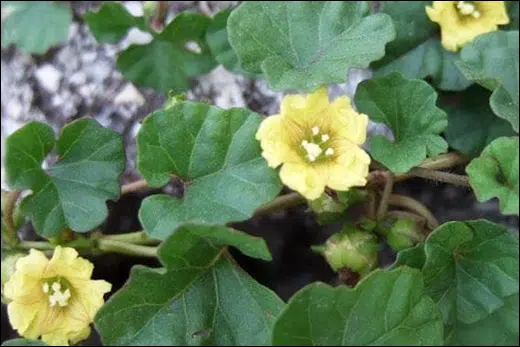Akhuparni / Ipomoea reniformis – Classification, Ayurvedic Properties & Dosage
Description
Akhuparni is a medicinal herb described in Ayurveda known for its diuretic, rejuvenative, anthelmintic, laxative and cures skin disorders property. In Modern Science, ipomoea reniformis shown as Antioxidant, Anti-hypertensive, Analgesic, hepatoprotective, Antidiabetic, Anti convulsant, Anti urolithiasis, Antipyretic, Anticancer activities.

Synonyms
- Mushikaparni
- Akhukarni
- Chitra
- Dravanti
- Leeka
- Vrushakarni
- Bhaudaribhava
Other Vernacular Names
- In Hindi – Chuhakanni
- In English – Roundleaf bondweed
- In Tamil – Elikatu Keerayi
- In Telugu – Ellika jemudu
- In Bengali – Indurakani
- In French – Sathar
- In Nepal – Chhatbatiza
- In Persian – Goromusha
Taxonomical Classification
- Kingdom – Plantae
- Division – Mangoliophyta
- Class – Magnoliopsida
- Order – Solanales
- Family – Convolvulaceae
- Genus – Ipomoea
- Species – Reniformis
Habitat
It is widely distributed all over the India, notably in the wet areas of the upper Ganges plains, Gujarat, Bihar, west Bengal, Western Ghats, Goa, karnataka, and Tropical Africa.
Morphology
It is a perennial creeper having a prostate stem, rooting at nodes, sparsely hairy. The leaf-blade is ovate-reniform rounded at the apex and looks like the ear of the rat, so known as Chahaparni or Akhuparni. The flowers are axillary, peduncles are short or absent, yellow coloured petals with dark base. The seeds are glabrous, long and dark brown.
Classical Classification
- Charka – krimighna mahakashaya
- Sushrta – Surasadi gana
- Shodala nighantu – Nama sangraha
- Raja nighantu – Guduchyadi varga
- Kaiyadeva nighantu – Aushadi varga
- Bhavaprakasha nighantu – Guduchyadi varga
- Shaligrama nighantu – Guduchyadi varga
Ancient Verse
Shloka – 1
आखुकर्णी त्वाखुकर्णपर्णिका भूदरीभवा |
आखुकर्णी कटुस्तिक्ता शीतला लघुः |
विपाके कटुका मूत्रकफामयकृमिप्रणुत् ||२५९||
Reference – Bhavaprakasha nighantu / Guduchyadi varga/shlok 259
Interpretation of Shloka – Akhukarni is also known as karaparnika Bhudaribava in Ayurveda. It has katuksha (pungent), seetla (cold), laghu (light) Vipaka katuka /bitter in consequence, mutrphayaa (urinary, phlegmatic), kreempranod (worm repellent) properties.
Shloka – 2
आखुकर्णी कटूष्णा च कफपित्तहरा सदा |
आनाहज्वरशूलार्ति नाशिनी पाचनी परा ||६८||
Reference – Raja nighantu / Guduchyadi Varga/ Shloka 68
Interpretation of Shloka – Akhukarni is bitter in taste and always destroys phlegm and bile. It is supremely digestive and destroys fever, cough and pain.
Ayurvedic Properties
- Guna (qualities) – Laghu (light for digestion), Ruksha (dry in nature), teekshna (strong)
- Rasa (taste) – Katu (pungent), Tikta (bitter)
- Prabhava (Special Action) – Krimighna (Act against worms)
- Veeraya (Potency) – Ushna (hot)
- Vipaka – Katu (Pungent taste after digestion)
- Karma (actions) – Kapha vata shamaka (reduces vitiated kapha and vata doshas)
Practical Uses / Benefits
There are many practical uses and applications in ancient as well as recent times, discussed as below:
- In past times roots were used to treat vaginal infections.
- Juice is used orally in skin disorders.
- Decoction of Akhuprni is mixed with sugar and given in case of fever by worms.
- In nasal congestion, a mixture of Akhuparni and Bhringraja juices are used as nasal drops.
- In earache, the leaf extract is mixed with sesame oil and instil the drops into the ear.
- The decoction of whole plant in 40-50 ml is used to treat asthma and cough.
- Roti made up of rice with juice of akhuparni is given along with oil of vidang and salt for deworming.
Part Used
All plant parts are used
Dosage
- Churna / Powder: 0.6 to 1.2gm of crude powder
- Dravya / Liquid: 10-20 ml of extract
Ayurvedic Products
As per mentioned in Ayurveda.
Conclusion
Akhuparni is widely used in ancient times for treating my problems such as skin infections, flu,cough, urinary infections and also used as a worm repellent mentioned in Ayurvedic scriptures. But in recent times, many other properties such as Anticonvulsant, Antipyretic, Anti cancer, Anti diabetic, Antioxidant are discovered that makes the herbs more therapeutically important in future.



